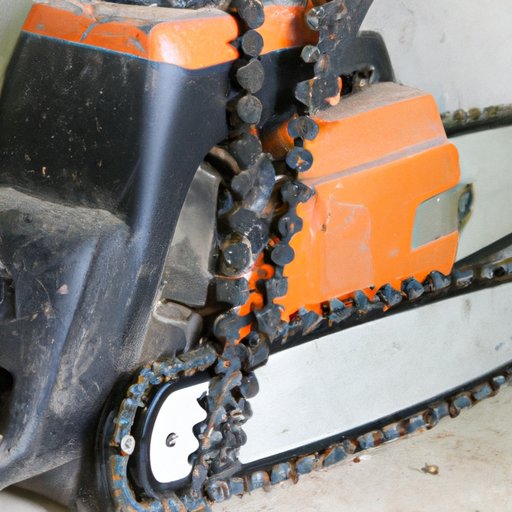
Introduction
If you own a chainsaw, you need to know how to properly maintain and sharpen its chain. A dull chain can lead to dangerous situations while operating it and reduce your chainsaw’s efficiency. In this comprehensive guide, we’ll provide you with a beginner-friendly step-by-step guide on how to sharpen a chainsaw chain, essential tools you’ll need, and safety precautions to keep in mind while doing it.
Step-by-Step Guide
Before we start, it’s essential to remember that the steps vary depending on the type of chainsaw you have. However, the principles of sharpening chainsaw chains are the same and can be applied several types of chainsaws.
The following step-by-step guide covers the essential areas of sharpening the chainsaw chain:
1. Cleaning the Chain
Begin by thoroughly cleaning the chain, including removing any debris or sawdust that has accumulated. Use a clean rag and a brush to clean the chain’s teeth and cutters.
2. Dismounting the Chain
The next step involves dismounting the chain from the chainsaw itself. Remove the chain carefully without twisting or pulling it too hard to avoid damaging it. Once it’s removed, place it on a flat surface where you’ll be starting the sharpening process.
3. Filing the Cutters
Make sure that each cutter on the saw chain is sharpened evenly by using a round file that matches the manufacturer’s specifications. It’s important to ensure that the round file is of the right size and matches the chainsaw specifications. Hold the chainsaw in place and ensure that you sharpen each tooth at the same angle. Sharpen one tooth at a time, moving to the next and repeating the process until all teeth are sharpened.
4. Setting the Depth Gauge
After sharpening the cutters, use the depth gauge tool to set the depth gauges’ height to a safe level. Like the cutters, each depth gauge should be set to the same height to ensure the chain’s proper functioning.
5. Re-mounting the Chain
After completing the sharpening process, re-mount the chain onto the chainsaw, ensuring that the chain is tensioned correctly (refer to the chainsaw manufacturer’s guidelines for proper tensioning). Once the chain is tensioned correctly, start the chainsaw and let it run for a few minutes to ensure it’s functioning correctly.
6. Checking the Chain’s Tension
Once the chainsaw is functioning correctly, double-check that the chain’s tension. A chain that is too loose can cause the chain to slip, while one that is too tight can cause it to bind and overheat. Check it regularly as continued use can cause it to loosen over time.
Video Tutorial
If you’re unable to understand or follow the steps mentioned above, watching a video tutorial can be incredibly helpful. Visual demonstrations can help you understand the techniques better. Below is a video tutorial that you can follow:
Essential Tools
To sharpen your chainsaw’s chain correctly, it’s essential to have the right tools on hand. You’ll require the following:
1. Round Files
This tool is used to sharpen the cutters on the chainsaw chain. They come in various sizes and must match the chainsaw’s specifications.
2. File Guide
A file guide ensures that the tooth cutters are sharpened at the correct angles. It’s important to have a file guide to ensure that you’re sharpening each tooth at the same angle, ensuring that the chain works evenly.
3. Flat Files
Unlike the round files, flat files with a handle ensure that the depth gauges are levelled appropriately.
4. Depth Gauge
Depth gauge tools help set the height of the depth gauges. It ensures that all depth gauges are the same height, contributing to the chain’s proper functioning.
5. Chainsaw Sharpening Machine (Optional)
If you cannot sharpen a chainsaw manually, chainsaw sharpening machines are available that can sharpen the chain in no time. They are handy and can help obtain professional results.
Safety Precautions
Sharpening a chainsaw can be dangerous if appropriate safety measures aren’t followed. Make the following safety precautions a priority
1. Wearing Protective Gear
When operating a chainsaw, wear gloves, safety glasses, and noise-cancelling headphones to protect yourself from flying debris and hearing damage.
2. Handling the Chainsaw Correctly
Following the chainsaw’s proper handling techniques will prevent the chainsaw from cutting or damaging its user. Grip the chainsaw with both hands, keeping your feet securely planted on the ground while in use, and always be aware of the chainsaw blade’s position.
3. Protecting the Chainsaw’s Kickback Safety Features
A chainsaw has several safety features in place that protect the operator from the saw’s kickback when operating it. Make sure these features are working accurately and aren’t disabled to maintain maximum safety while operating the chainsaw.
4. Working on a Flat, Clean Surface
Working on a flat, clean surface helps prevent accidents and makes the sharpening process easier. It’s a safety measure to avoid slipping or moving objects.
Best Products
Using the proper tools can help get the job done accurately and safely. Here are some of the top-rated sharpening products on the market:
- Granberg Bar-Mount Chain Saw Sharpener
- Stihl 2-in-1 Easy File Chainsaw Chain Sharpener
- Oregon 30846 12-Volt Sure Sharp Chain Saw Sharpener
General Maintenance
Proper maintenance of the chainsaw chain can help reduce the frequency of sharpening, prolonging the chainsaw’s life and maintaining its efficiency. Here are some tips:
- Clean the chain after every use to remove any debris.
- Avoid the chain hitting the ground, as this can dull or damage it.
- Keep the chain lubricated, as this reduces friction and heat.
- Use a chainsaw wedge to avoid pinches and binds.
Conclusion
Sharpening a chainsaw chain is an essential maintenance task that has its fair share of risks if not done correctly. By understanding the steps, using the right tools, and taking proper safety precautions, you can perform the task effectively and safely. Following the steps provided here can help ensure your chainsaw’s longevity and efficiency, providing you with a well-functioning tool for years to come.




